Guide to Facebook Reach: What Marketers Need to Know
Do you want more fans to see your Facebook updates?
If so, you need to understand Facebook reach.
In this article, you’ll find out what Facebook reach is, why some pages have more visibility than others and how to improve your own Facebook page reach.
What Is Facebook Reach?
Facebook is always rolling out new features in an effort to give users a more seamless and useful experience. Unfortunately, that doesn’t always work in your favor when it comes to reaching as many people as possible with your page content.
Facebook reach is the number of unique people who saw your content. It affects every other metric you can track: engagement, likes, comments, clicks and negative feedback. And that’s not all. There are different kinds of reach: post, page, organic, viral and paid. Everythingon Facebook boils down to reach.
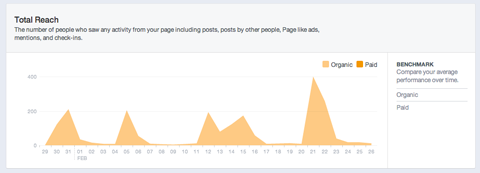
Total Reach on Facebook.
Post reach and page reach, for example, are different and have different weight. Post reach is the number of people who saw a specific post in their news feed. Page reach is the number of people who saw any of your post content during a given period of time (daily, weekly or monthly).
These two reach metrics can be deceiving or confusing. If you don’t post very often, you may have a very high post reach, but a low page reach. If you post often (e.g., five times a day or more) you may have a low post reach, but a pretty high page reach.
Which one should you focus on? Ask yourself whether you want to have individual posts seen by the most fans or make sure your brand gets in front of your fans on a regular basis. Your answer determines which form of reach—post or page—is more important to you.
Post and page reach both have three main subcategories: organic, viral and paid reach.
Organic reach is the reach Facebook gives you for free. It happens in the news feed when your fans see your updates. There are other possibilities, such as random users visiting your page, but these are insignificant compared to news feed views by fans.
Viral reach consists of the people who see your content because someone else created a story about it. For example, if a fan likes, comments or shares your post, their friends will see your post even if they aren’t fans of your page. The same is true if you’ve paid to reach larger audiences who may or may not already be your fans. If one of those targeted people creates a story, their friends will see it as well. Both are viral reach.
A quick note about viral reach: When you export your Insights data to an Excel spreadsheet, viral reach data is still included when you select the old Insights format. However, viral reach is a subsection of organic reach in the new version of Insights, which was rolled out in 2013. Expect to see viral reach metrics totally disappear from your Insights and the Facebook API soon. Facebook has decided to go for simplicity rather than detail.
Paid reach is a subset of post reach and is pretty easy to track and report. You paid for it, so you know where it came from. If you pay to promote your posts, your post reach is going to be much bigger than your standard organic reach (because you’ve paid to reach more of your fans).
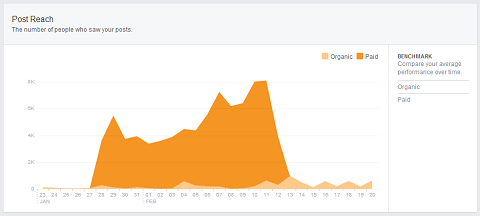
You can find paid reach metrics under the Post Reach area in Facebook Insights.
What’s the Best Way to Measure Facebook Reach?
Until recently, it’s been common to benchmark your overall Facebook reach against your total fans (even I was doing this). Many social media marketers checked the number of people reached for a given post, and then compared it to their total number fans and calculated a percentage of how many fans they reached. That’s no longer the best way to look at it.
Facebook’s new Insights gives you access to the number of fans who are online at any given point in time. A Facebook page post lifespanrarely exceeds 2 to 3 hours.
Given that, we should benchmark against the total number of fans who were on Facebook at that time.
For example, in the graph below I can see that most of my fans are logged into Facebook around 3:00pm. If I post at that time, about 3,500 of my 9,500 fans should be logged in.
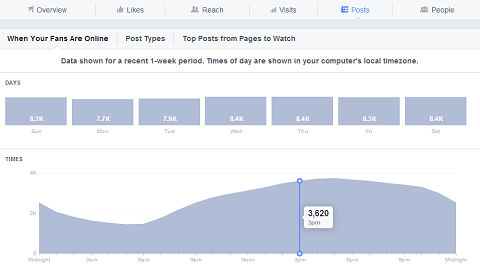
Use the When Your Fans Are Online option to find out when most of your fans are logged into Facebook, then post at that time and use that reach as your benchmark.
If the post reaches 600 people, I shouldn’t look at it as 6.3% of my page’s fans (600 people out of 9,500), but rather 17% of the fans (600 out of 3,500) who were online and reachable when I posted it. This is important when you’re explaining page performance to a boss or client. These are the results your hard work is producing!
How Hard Is It to Get Good Reach?
In December 2013, people started reporting a big drop in organic reachfor the pages they were managing. The drop in organic reach varied—some saw a large drop, some saw a small drop and others saw no change.
A post from AdAge revealed a “leaked” deck from Facebook stating that pages should expect their reach to continue decreasing and be ready to pay for visibility in the news feed. The social media ecosystem and blogosphere were outraged.
Not a single day in December passed without a new blog post on the subject. Some were condemning Facebook for contriving sneaky new ways to steal their money. Others were defending Facebook’s efforts to improve the quality of content distributed in the news feed.
On December 20, I looked at the average data of more than 6,000 pages of various sizes and industries. The data shows a constant decline over the previous six months, but no noticeable drop in December (when people started reporting the issue). However, I did discover an interesting trend.
Pages with high post engagement were the least affected (if at all). Pages with a high engagement rate along with a high negative feedback score (i.e., users hide your posts or report them as spam) were more affected. Finally, pages with a very low engagement rate were affected most.
The average monthly organic reach declined from 73% to 55% of fan base (orange graph). Notice there’s no significant drop in December for the average. However, that average decline has not affected every page.
The black graph represents the evolution of a nonprofit page I manage and its monthly organic reach has increased during the same period. That page has very high post engagement and very low negative feedback.
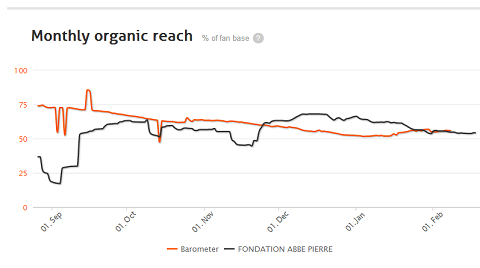
Working to increase post engagement may help you reach more fans in the news feed.
The type of content a page published also had an impact. Photo posts had the most negative effect, so if you post a lot of photos and have a low engagement rate, you’re probably suffering more than the average page.
Do Other Social Networks Offer Better Reach?
When the Facebook reach issue was ignited in December, many social marketers branded Facebook as a fraud and advised that it was time to move on to other social networks, Google+ being the lead contender. That emotional reaction was inherently wrong on all levels.
The most important flaw in that plan is that other social networks don’t provide any kind of reach metric. Only Facebook provides that data. When the other networks do provide analytics, they’re nothing close to the breadth of information Facebook gives page owners.
Most social marketers were upset about the pay-to-play aspect of Facebook’s new reach algorithm. They blamed it on Facebook being a publicly traded company and accused it of only being out for money.
Consider this: Do you think Google is acting as a nonprofit with no interest in monetizing you and your data? Google’s changes to its search algorithm (e.g., Panda, Penguin and Hummingbird) have been far more damaging to online businesses than Facebook’s reach tweaks. When a business’s free SEO ranking goes dark, in many cases they pay for AdWords to stay in front of their audience.
Facebook has one of the best targeting options for businesses. For some of us, leaving Facebook to rely solely upon Google AdWord’s targeting capabilities would be business suicide.
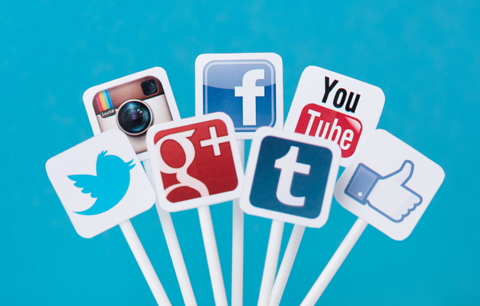
Don’t automatically discount Facebook from your social media mix. Image source: iStockPhoto.com.
Overall, Facebook, Google+, Instagram and Twitter are different and complementary, not opposing alternatives to each other. Look at Facebook as a component of your strategy, not the whole thing.
If most of your audience is on Pinterest or Google+, focus more energy there, but why leave the place where the people you need to reach are spending all of their time?
Does Paying for Facebook Reach Give a Good Return on Investment?
For some, paying Facebook for exposure will become a necessity. Is this such a bad thing? Should you be concerned about the need to pay to increase your content visibility? Not necessarily.
Of course, some content doesn’t deserve to be paid for and some does. Paying to promote the right content in order to reach more people in your target audience (fans or not), can lead to a lot of conversions.
First, make a distinction between casual content and business-worthy content. Photos from your latest speaking gig, videos of fun things you do at the office and quick news updates about your niche are all relevant and good, but should you pay to get more exposure for them? Nah. Those posts don’t impact your bottom line.
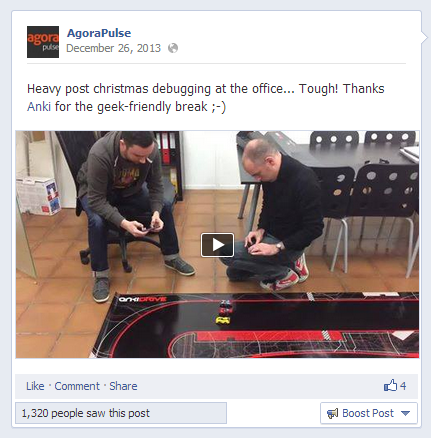
When you post about fun stuff you do at the office, it’s not about reaching a big number of your fans.
But if you’re announcing a new product, new features, an ebook or webinar or other content you’ve spent hours on, isn’t it worth it to pay $30 or $50 to make sure your hard work is seen by 9,000 people instead of 1,000? Yes! Your time and specialized content are worth it. Why waste those efforts to save $30 or $50? That’s nonsense.
If you’re sharing the type of content you can track for short-term ROI(e.g., leads or revenue), isn’t it worth it to pay $100 or $150 to generate 300 or 400 hot qualified leads or 10 new subscribers with a lifetime value of $400? You bet! Actually, for this kind of content, I haven’t found a more affordable way to generate ROI with PPC, and I’ve tried a LOT of options.
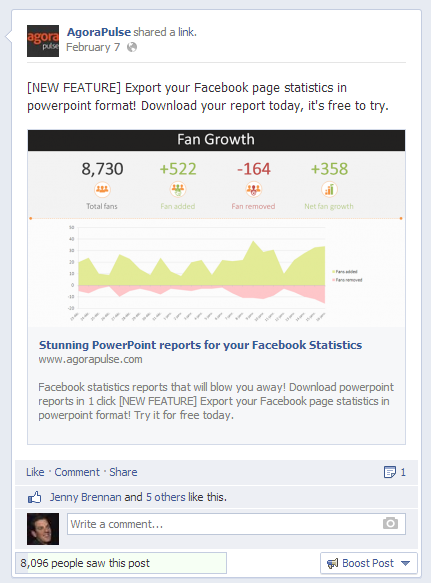
When posting about a new product or feature that can generate new customers, it’s worth it to pay for more reach.
In the example below, the cost to acquire a new customer via sponsored posts was between $20 and $30, which is around 10% of our average revenue per customer. Pretty good return on investment as far as I’m concerned.

Paying for extended reach can result in higher ROI.
What Are the Best Tactics to Sustain Facebook Reach?
If you want to make the most of Facebook reach this year, I have a few ideas on how to do that. Posting relevant curated content or reposting your own evergreen content are great ways to encourage engagement (which translates to reach), especially when you post when your fans are on Facebook.
Posting more often and at different times of day are your best tactics to increase your overall reach and brand awareness. Pages that post at least three times a day get very high page reach metrics and much more brand awareness than pages that only post once a day or fewer.
In the example below, the page on the left has a pretty high post reach (24% of fans are reached for each post!). The page on the right has a much lower post reach. However, the page on the right posts several times a day while the one on the left only posts once a day. The overall page reach is much higher for the one on the right (93% of fans reached on a monthly basis versus 53%). Neither of these pages are using paid reach; it’s all organic.
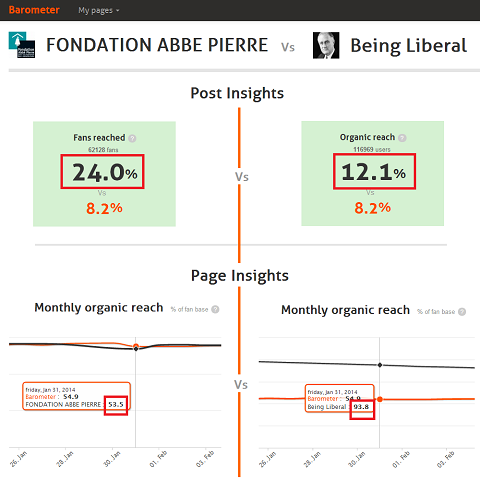
Posting frequency affects your post and page reach.
Creating consistently great content is hard. If you’re relying on great content produced in-house to nurture your Facebook page, you need to change your approach.
Curation is the cheapest and most effective way to produce more high-quality, shareable content. There are plenty of experts in your industry, and they all invest a ton of time crafting great content. Have the right curation tools in place to help you spot content quickly and share the best of it on your page. Remember, the goal here is brand awareness. You’ll get that by sharing high-quality content for your audience to see.
Other types of content you can share are events like attending or speaking at a conference or even appearing on a TV or radio show. This kind of post takes less than five minutes to do—you just need to add them into your daily routine.
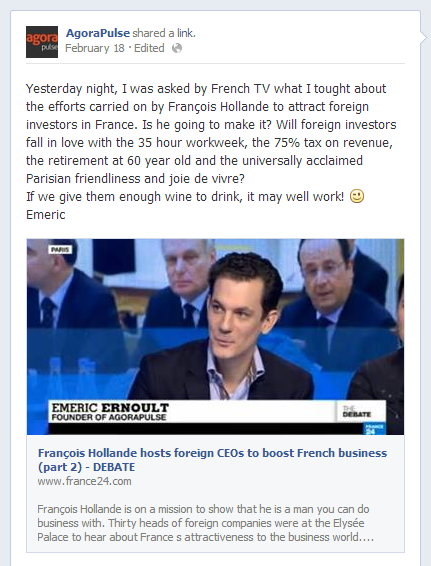
Sharing your special events gets your brand in front of fans and keeps them in the loop.
Sharing content doesn’t have to be a “go big or go home” scenario. Sharing quick nuggets of content along with your in-depth blog articles mixes things up and keeps it interesting.
Post a fun fact or an expert opinion or question about the latest news in your industry. When you find an interesting article that’s relevant to your niche, just hit Share and add a small introduction. This kind of content is super-easy to create and sustains brand awareness.
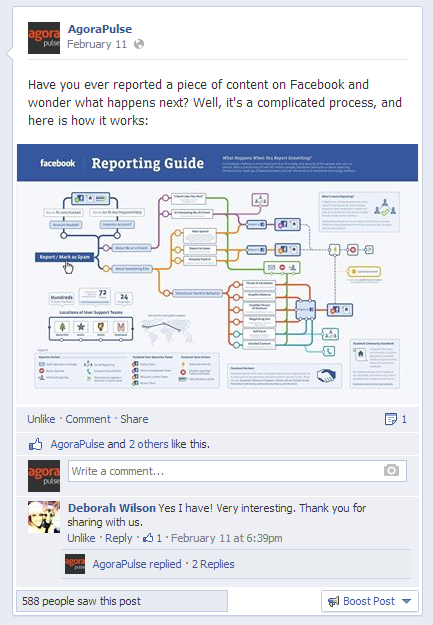
Share interesting content relevant to your fans for more engagement and reach.
Don’t forget your evergreen content! Once a week, plan to reshare your best and most costly pieces of content to get them in front of new fans.
Jon Loomer does this a lot and it’s one of his tricks that allows him to post 2 or 3 times daily. Here’s a post on Jon Loomer’s Facebook page published on February 9 about a blog post originally published on November 18. It’s still getting likes, shares and clicks!
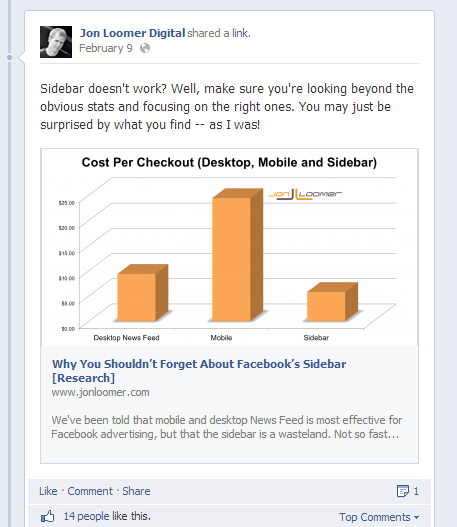
Don’t waste your evergreen content; it deserves to be shared again and again.
While it can be frustrating when Facebook changes the rules of the game, you can still use the network to your advantage. Understanding how reach affects all reported data, choosing content wisely and paying to promote posts that can result in conversions can put you ahead in the end.
Guide to Facebook Reach: What Marketers Need to Know
![Guide to Facebook Reach: What Marketers Need to Know]() Reviewed by Daniel Chuks
on
06:32
Rating:
Reviewed by Daniel Chuks
on
06:32
Rating:

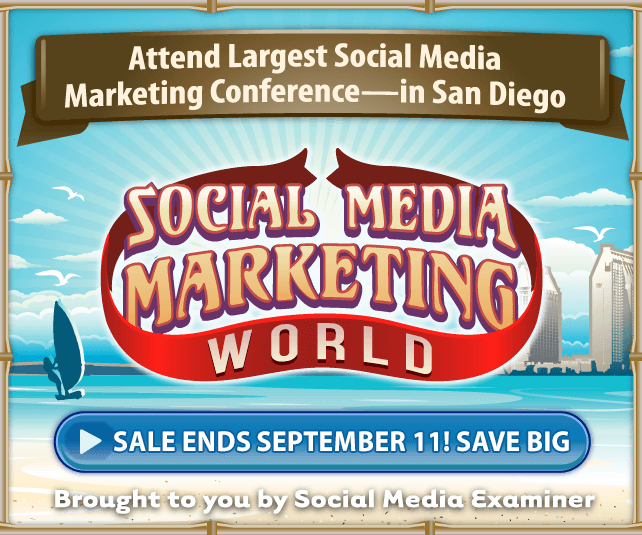
No comments